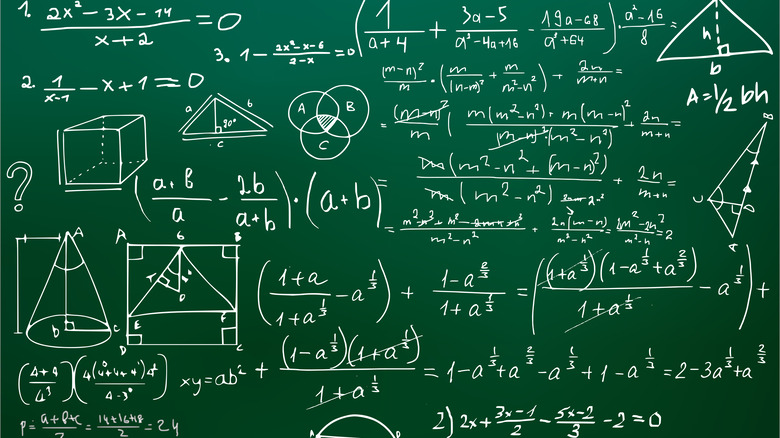The Strange Connection Between A Famous Mathematician And The Kevin Bacon Game
For a couple of decades, there's been a game of sorts that is also kind of a pop-culture joke (via The New Zealand Herald). In the Kevin Bacon Game (or alternately, Six Degrees of Kevin Bacon), the goal is to name an actor, living or dead, and tie him or her to Kevin Bacon, ideally in six steps or fewer. The wide variety of movies in which Bacon has starred or played a supporting role, across multiple genres and with multiple other actors, formed the basis for the game. Because Bacon has done so much with so many other actors, it's a pretty good bet that just about any actor with a speaking credit is connected to the "Footloose" star through six or fewer steps.
Three decades before the Pennsylvania men came up with the Bacon game, however, mathematicians were playing a similar game with one of their own, according to Bloomberg. These academics will tout their own Erdos Number, which is the "collaborative distance" between them and one of the most prolific mathematicians in the world.
Prolific Mathematician Paul Erdos
Academics live and die by getting published in peer-reviewed journals. According to a report by the Journal of Research in Medical Sciences (via the National Library of Medicine), there's a phrase in academia, "Publish or perish," which basically states that an academic's career trajectory can be tied to how often they get published in those journals.
Hungarian mathematician Paul Erdos didn't write just one or two academic papers. He wrote around 1,500 of them, according to Bloomberg, largely on number theory and combinatorics. "I fell in love with numbers at a young age. They were my friends. I could depend on them to always be there and always behave in the same way," said the academic (via Britannica), who at 3 years old could amuse his mother's friends by multiplying three digits by three digits in his head.
So dedicated was Erdos to publishing and collaborating with other academics that in his later years, he worked as much as 20 hours per day, possibly with the help of amphetamines, spurring other researchers to collaborate with him and tackle projects on their own.
The Erdos Number
So prolific was Paul Erdos at producing academic papers and — more importantly — collaborating with other mathematicians that at some unspecified point in his career, some colleagues came up with the idea of the Erdos Number, which is to say, the number of steps between one mathematician and Erdos (via Britannica). For example, the 507 mathematicians (Bloomberg says it's 511) who collaborated with the Hungarian directly have an Erdos Number of one; those who collaborated with one of his collaborators have an Erdos Number of two, and so on. Albert Einstein, for example, never collaborated directly with the Hungarian, although he collaborated with a collaborator, giving him an Erdos Number of two. So far, the collaborator with the greatest number of steps between him and the original was 15.
Further still, Britannica notes that academics who aren't mathematicians all have Erdos Numbers of infinity simply because they're not mathematicians. However, perhaps there's some wiggle room here, because multiple disciplines can and do brush up against mathematics. So theoretically, for example, a biologist could have an Erdos Number if they collaborated with a mathematician at some point.
Math Upon Math
There's more to the Erdos Number than just being a fun data point in the discussion of mathematics. There are real implications to having such a number and to what the number means more broadly.
Speaking to Bloomberg, Peter Carr said that in math circles, a low Erdos Number is something of a badge of honor. "It's a fun thing, an inside joke that shows mathematicians have a sense of humor. It's a measure of network connectivity, who you have worked with," Carr said. And indeed, groundbreaking math, with real-world implications, has been completed by individuals with low Erdos Numbers. For example, Bloomberg mentions multiple individuals employed in the hedge fund industry with numbers in the range of three.
Further still, the concept of an Erdos Number is itself a field of study in mathematics, or math on math, if you want to take the meta view. According to Mathematical Investor, research has been done on the output of mathematicians with regard to their Erdos Number. And the Erdos Number was itself a factor considered in the academic paper, "The structure of scientific collaboration networks" (available via the National Library of Medicine), which takes a look at the role of networks and collaboration in academia.
Why Stop At Math?
As mentioned above, Britannica claims that nonmathematicians have Erdos Numbers of infinity. However, the august encyclopedia appears to be wrong on this point. The Erdos Number Project, which is as close to an official set of rules for this "game" as we're going to get, lists off thousands of people with Erdos Numbers of one or two, and not all of them have been mathematicians. As previously noted, multiple fields brush up against math, and many researchers in those fields have collaborated with researchers who have collaborated with Paul Erdos.
For example, Lior Pachter is a computational biologist, and he has an Erdos Number of two, while a fellow biologist, Richard Lenski, clocks in at three. At least one politician also has an Erdos Number: Angela Merkel, chancellor of Germany from 2005 to 2021, has an Erdos Number of five, according to Oakland University. Astronomer Carl Sagan had an Erdos Number of four.
Why Stop At Just Erdos Numbers?
Most readers who are not academics and/or mathematicians were likely familiar with the Kevin Bacon iteration of this concept before learning about its mathematical underpinnings. However, what if the Erdos Number and the Bacon Number (the number of steps between an actor and Kevin Bacon) were combined? Then we have Danica McKellar (pictured above). The "Wonder Years" actress got a degree in math and has an Erdos Number of four (via Erdos Number Project) and a Bacon Number of two.
And then there's the Erdos-Bacon-Sabbath Number. According to Arizona State University, Black Sabbath has had 35 touring and session members over the decades, leading to a version of this "game" in the music industry. To have an EBS number, you have to have written an academic paper that connects to Erdos, appeared in a film that connects to Bacon, and performed on an album that connects to Black Sabbath. ASU professor Lawrence Krauss, on learning that he, like Lisa Kudrow and Stephen Hawking, had an EBS number, cracked wise in the way that only a professor can. "Any time I can be sandwiched between Lisa Kudrow and Stephen Hawking — not literally, but metaphorically — it's a good thing," he said. He got there by publishing an academic paper, appearing in a documentary, and narrating a classical performance for an orchestra; all of those works connected in some way or another back to Erdos, Bacon, and Black Sabbath.





